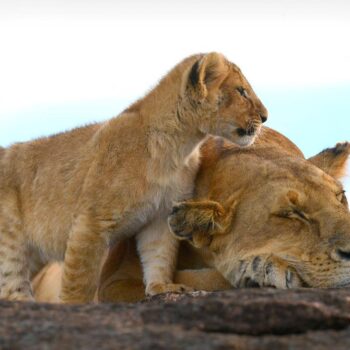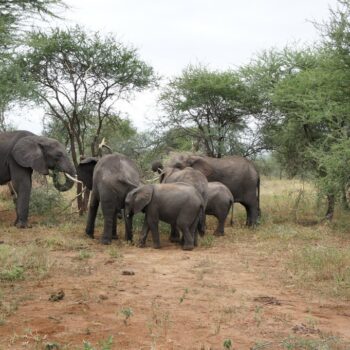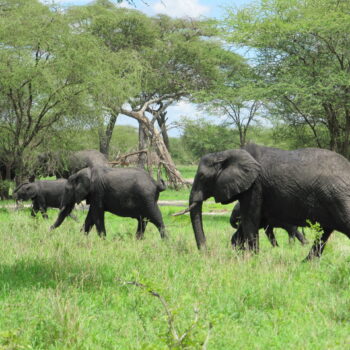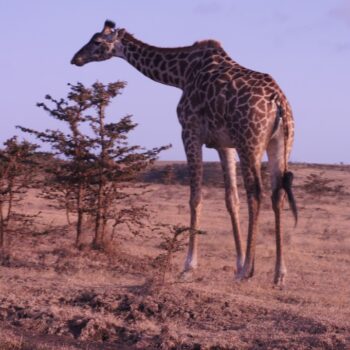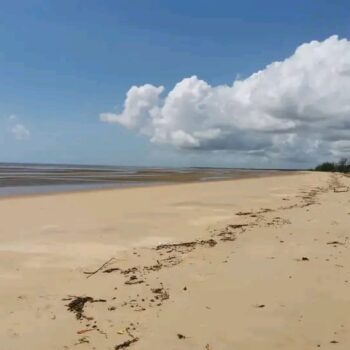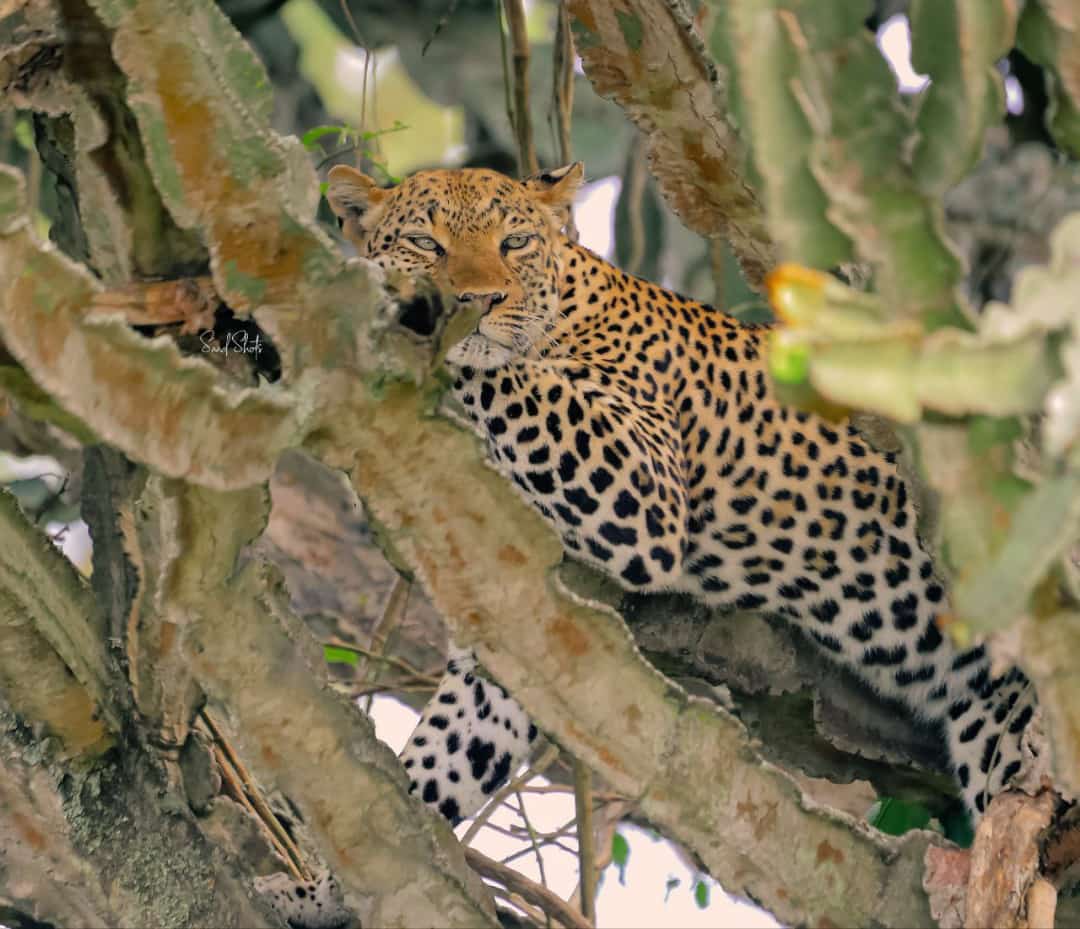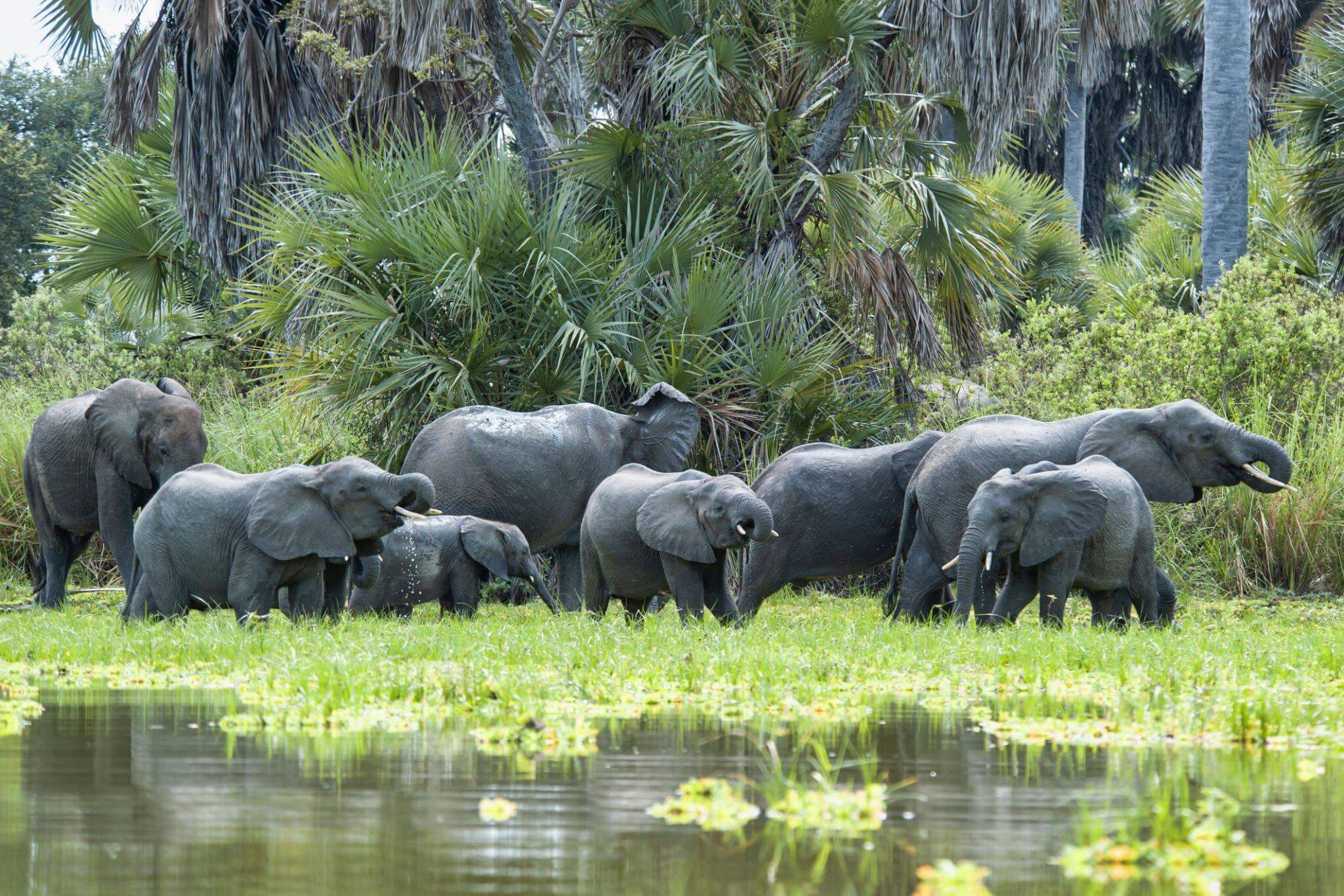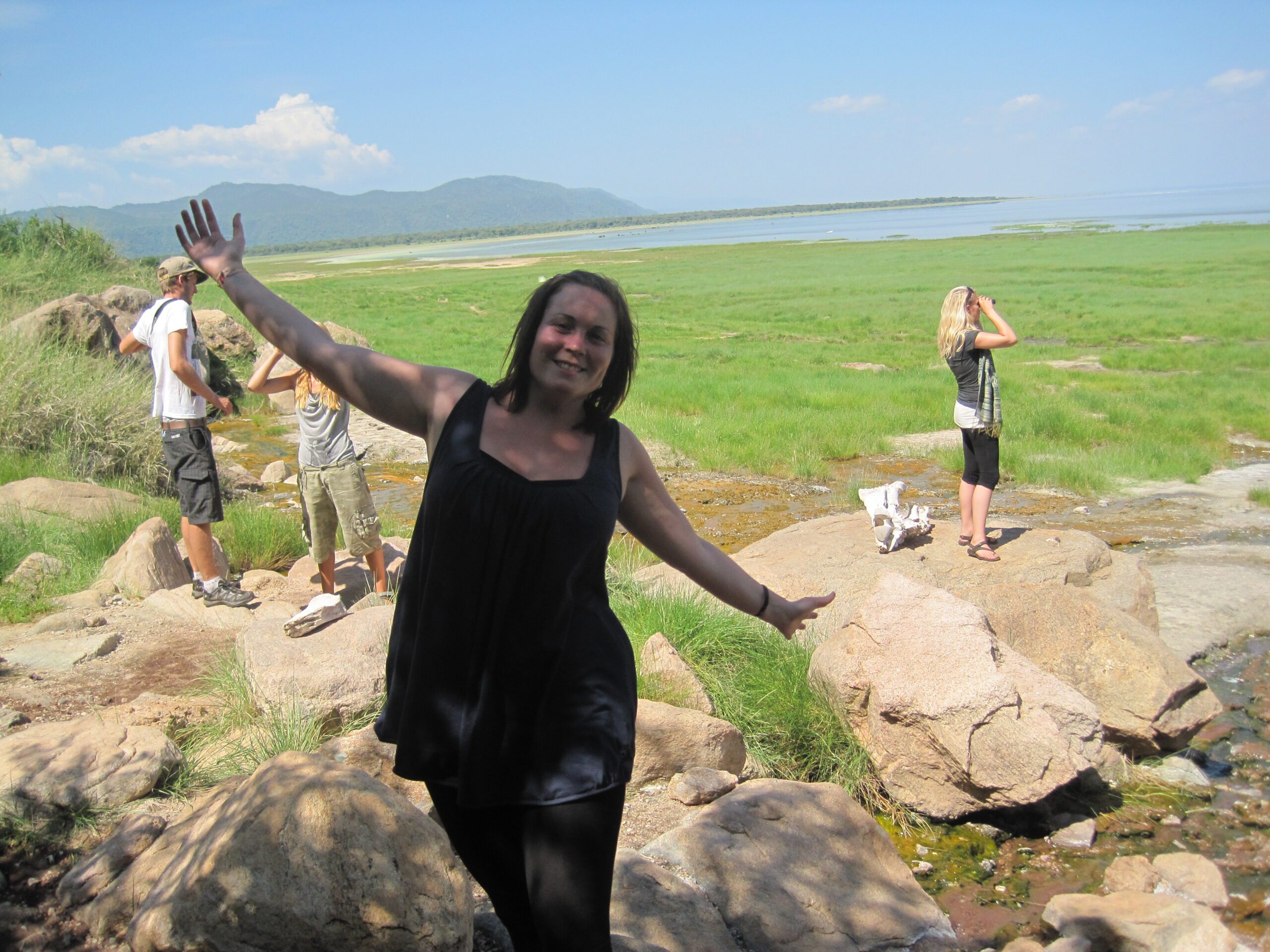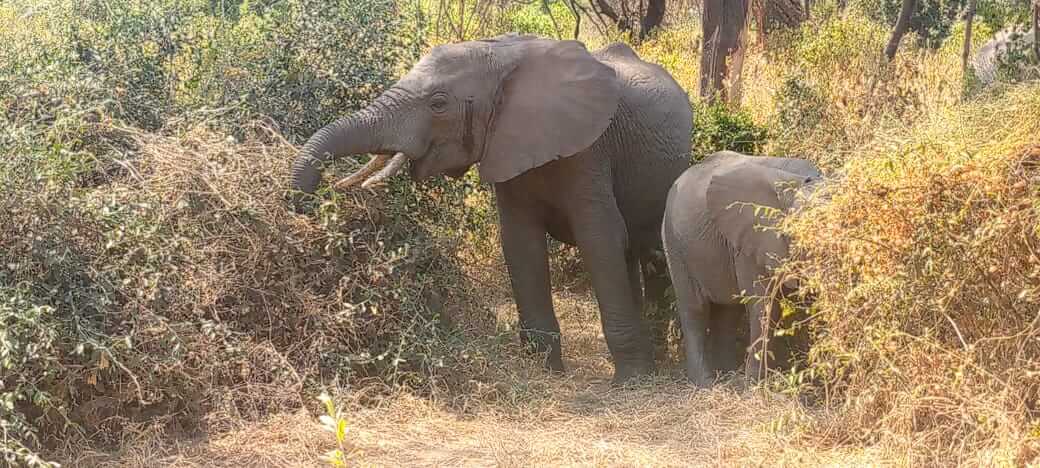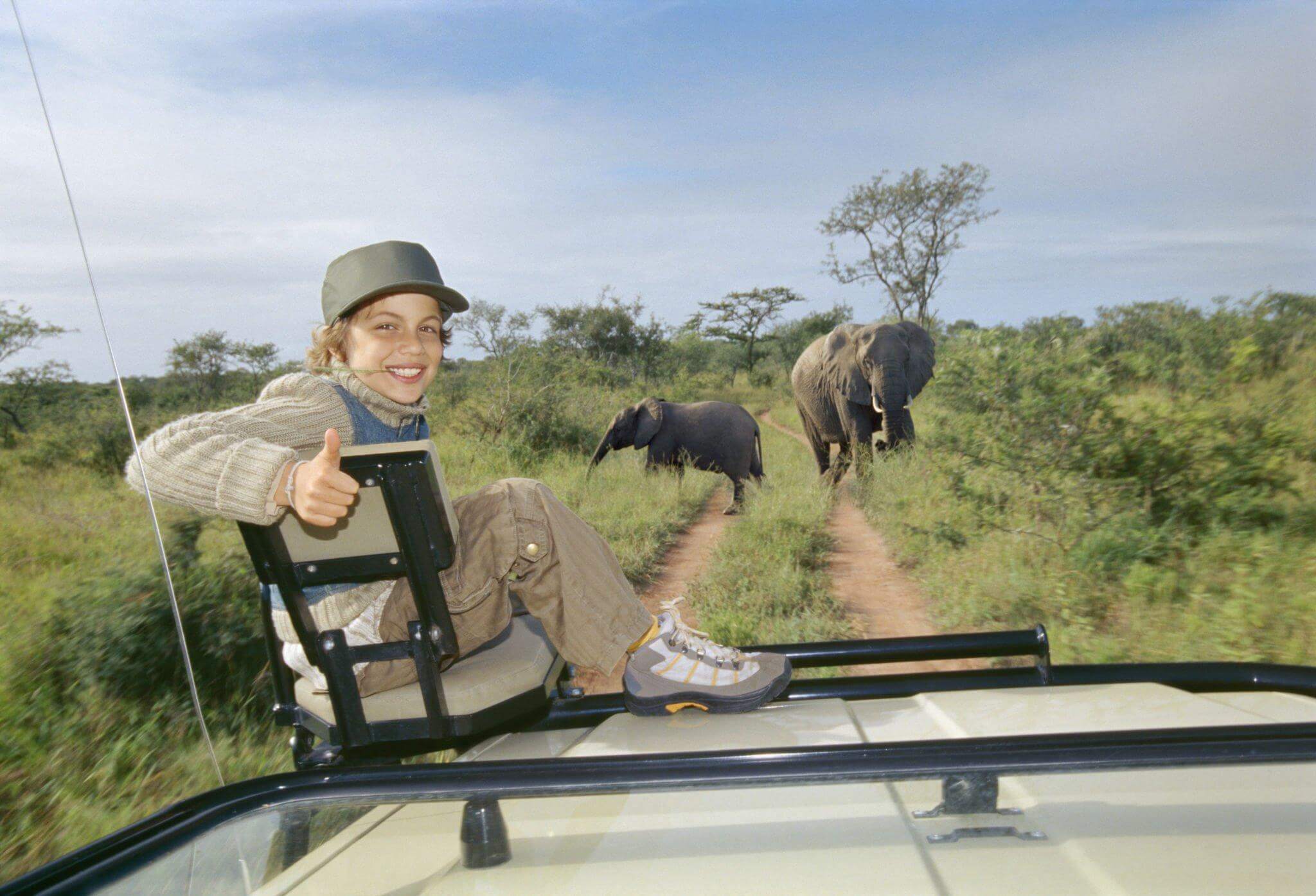SOUTHERN CIRCUIT
NYERERE NATIONAL PARK
Enter Africa’s largest protected area uninhabited by man, where Tanzania’s greatest population of elephants wander in an area bigger than Switzerland! The Selous (pronounced “Seloo”) is considered important enough to be World Heritage Site, in which the lucky few can experience a safari in an absolutely wild and unspoiled bush.
The park is named after Englishman, Frederick Courtney Selous – conservationist, hunter, explorer, and author, whose adventure books on Africa became best sellers in Victorian England.
The park varies from rolling grassy woodlands and plains to rocky outcrops cut by the Rufiji River – the lifeblood of the park, whose tributaries form a network of lakes, lagoons, and channels. Volcanic hot springs even burst forth in places. The Rufiji offers a superb method of game viewing especially during the dry season when animals congregate.
ANIMALS AND AQUATIC LIFE
Selous contains about one-third of all the wild dogs (often called painted dogs), in the world. Their need to roam vast areas and their formidable hunting skills have caused many to be shot by farmers, but here in Selous, they have boundless woodlands and savannahs in which to roam.
Along the Rufiji River, an array of grazing antelopes, crocodiles and hippos are commonly seen as well as black and white colobus monkeys in the riverine forests. During the dry season from June to October, the concentration of animals along the river is astonishing. Linked to the Rufiji is Lake Tagalala where waterbuck, reedbuck, and bushbuck gather at the water’s edge. Magnificent sickle-horned sable and curly-horned greater kudu tend to keep to the longer grass and wooded shrubby areas.
In the dry season, an ancient migration of elephants takes place between the Selous and Mozambique’s Niassa Game Reserves. This is one of the largest natural transboundary eco-systems in Africa and at the last consensus, it was estimated that 64,400 elephants roam the two parks, with 84% on the Tanzanian side.
Fierce tiger fish and smooth slippery vandu catfish are caught in the rivers. The latter is equipped with primitive lungs allowing it to cross land for a short distance in an attempt to find water during the dry season.
Largest National Park in Tanzania – southern Tanzania national parks
SEASONS
- Dry Season: The dry season sets in from June to November and is the best time for game viewing along the rivers. Elephants come out of the bush at that time and predators are more commonly seen.
- Rainy Season: January to April is wonderful for birdlife ad lush scenery but many roads become impassable after heavy rains. December to February is still good for game viewing but can be rather hot and humid. The safari lodges are usually closed from March to May.
SELOUS SPECIALITIES
- Rare and endangered Wild Dog
- Boat game viewing
- Fishing
- Thousands of migrating elephants
- Walking safaris
- Huge wilderness
When to go
- All Year Around
How To get there
- By Air
- By Land
MIKUMI NATIONAL PARK
Swirls of opaque mist hide the advancing dawn. The first shafts of sun color the fluffy grass heads rippling across the plain in a russet halo. A herd of zebras, confident in their camouflage at this predatory hour, pose like ballerinas, heads aligned and stripes merging in flowing motion.
Mikumi National Park abuts the northern border of Africa’s biggest game reserve – the Selous – and is transected by the surfaced road between Dar es Salaam and Iringa. It is thus the most accessible part of a 75,000 square kilometer (47,000 square miles) tract of wilderness that stretches east almost as far as the Indian Ocean.
The open horizons and abundant wildlife of the Mkata Floodplain, the popular centerpiece of Mikumi, draw frequent comparisons to the more famous Serengeti Plains.
Lions survey their grassy kingdom – and the zebra, wildebeest, impala, and buffalo herds that migrate across it – from the flattened tops of termite mounds, or sometimes, during the rains, from perches high in the trees. Giraffes forage in the isolated acacia stands that fringe the Mkata River, islets of shade favoured also by Mikumi’s elephants.
Criss-crossed by a good circuit of game-viewing roads, the Mkata Floodplain is perhaps the most reliable place in Tanzania for sightings of the powerful eland, the world’s largest antelope. The equally impressive greater kudu and sable antelope haunt the miombo-covered foothills of the mountains that rise from the park’s borders.
More than 400 bird species have been recorded, with such colorful common residents as the lilac-breasted roller, yellow-throated longclaw and bateleur eagle joined by a host of European migrants during the rainy season. Hippos are the star attraction of the pair of pools situated 5km north of the main entrance gate, supported by an ever-changing cast of waterbirds.
About Mikumi National Park
- Size: 3,230 sq km (1,250 sq miles), the fourth-largest park in Tanzania, and part of a much larger ecosystem centred on the uniquely vast Selous Game Reserve.
- Location: 283 km (175 miles) west of Dar es Salaam, north of Selous, and en route to Ruaha, Udzungwa and (for the intrepid) Katavi.
How to get there
A well-surfaced road connects Mikumi to Dar es Salaam via Morogoro, a roughly 4-hour drive.
Also road connections to Udzungwa, Ruaha and (dry season only) Selous.
Charter flight from Dar es Salaam, Arusha or Selous. Local buses run from Dar to park HQ where game drives can be arranged.
What to do
Game drives and guided walks. Visit nearby Udzungwa or travel on to Selous or Ruaha.
When to go
Accessible year-round.
Accommodation
Two lodges, three luxury tented camps, three campsites.
Guesthouses in Mikumi town on the park border. One lodge is proposed at Mahondo and one permanent tented camp at Lumaaga.
More information on Accommodation
UDZUNGWA MOUNTAINS SAFARI
Conservation Status :
National Park and one of the World Biodiversity hotspots. The full, official name is Udzungwa Mountains, National Park.
Established : 1992
Location: Southern Tanzania, 350 Kms from Dar es Salaam; 65 Kms Southwest of Mikumi
Size :1,990 Kms²
Maximum Length:80 Kms from Southwest to Northeast
Height A.S.L. :250 m (Mangula) – 2,576 m (Mt Luhomero). The second highest peak is Mt. Mwanihana (2,570 m).
Seasonal Variation: The areas covered by evergreen forests show no significant seasonal variation. The areas covered by miombo savanna are in the “rain shadow” and two well-defined seasons occur a dry season from May to October and a wet season from October to May. Trekking routes may be difficult during the period of heaviest rains in March-May.
Precipitation:Great variations occur depending on altitude and area: mean annual rainfall is 600 m (rain shadows in the north and northwest) – 2,000 m (lowland rain forests in the east and southeast). June – August is practically rainless in the North and Northwest. The Eastern mountains receive some rain all year-round at an altitude of more than equal to 1,500 m, but the rainfall is lower in June – October at altitudes of less than 1,500 m.
Temperatures :
There is a great variation depending on altitude and season. On the lowlands (250 – 500 m) temperatures are 26 – 34°C in the daytime and 18 – 21°C at night, but high up in the mountains (more than equal to 2,000 m) they are 18 – 25°C by day and occasionally close to 0°C at night.
Activities :
Hiking and mountain trekking–
One of Tanzania’s most beautiful wilderness areas, the Udzungwa Mountains National Park, is a high forest area and a haven for hikers. This 1,990 sq km park was formed in 1992 by combining several forest reserves.
The mountains are a part of the Eastern African Arc, a chain of ancient mountains which run from the Taita Hills in Kenya through the Pare and Usambara ranges to the Uluguru Mountains to Udzungwa. The park covers a wide range of altitudes, from 200 m to Luhombero Peak at 2,576 m, and is the only place in East Africa with an unbroken forest canopy over this entire elevation, ranging from miombo woodlands, bamboo forest, and lowland forest to montane forest and highland grassland.
Udzungwa’s wildlife is rich, containing Tanzania’s largest variety of primates, ten species including four not found anywhere else – these are the Sanje-crested mangabey, the Iringa (Uhehe) red colobus monkey, the Matundu galago, and the Amani mountain dwarf galago (bushbaby). Other primates include black and white monkeys, blue monkeys, and thick-tailed galago. Rarer animals include red duiker, blue duiker, sun squirrel, bushpig and bushbuck. Over 250 bird species have been recorded including the rufous-winged sunbird and Udzungwa partridge; both are rare endemics and over 1300 species of butterfly, of which 121 are endemic to Tanzania.
There are at least 5 unique species of amphibians and reptiles. Lion, leopard, buffalo and hippo are present but mainly in the less accessible parts of the park.
There are six hiking trails in the Park, ranging from an easy hour’s walk to a serious five-day hike up the park’s second-highest peak. The Prince Bernhard Trail starts from the park headquarters and goes to the small Prince Bernhard Falls named after the Dutch prince who as president of WWF opened the park in 1992.
Baboons are frequently seen here. Another short trail is the Sonjo Trail passing through miombo woodland and two waterfalls. Primates and birds are the main attractions on this trail.
The most popular route is the Sanje Falls Trail that heads through many forest zones to Sanje Falls, a succession of three waterfalls that drop over 170 m. The first two have splash pools you can swim in providing a refreshing experience; the third has the longest fall.
There is plenty of primates, butterflies, and birdlife on this trail. The Campsite 3 Circuit is best for wildlife, giving a chance to see bushbuck and duiker in addition to the primates, butterflies and birds. The Mwanihana Trail, takes you to Udzungwa’s second highest peak at 2,111 m. This trail takes three days and the walk can be very exhausting.
And the Lumemo Trail takes about five days and passes along the saddle between Luhomero and Mwanihama peaks. Here you may encounter herds of buffalo and elephant, also provides good bird watching. Armed rangers are needed for these last three trails. There are other paths that run through the forest. Porters and guides are available at the park offices.
Accommodation
There are two modest but comfortable lodges with en-suite rooms near the park entrance. Some camping areas have been established inside the park. More About accommodation here…
RUAHA NATIONAL PARK
Conservation Status: National Park
Established:1964
Location: Southern Tanzania
Size: 20,200 Kms² (Tanzania’s Largest National Park)
Maximum Length:260 Km. from Southwest to Northeast
Height A.S.L. :Ca. 1,000 m. Some scattered hills in the west rise up to 1,800 m (Lyambagari 1,816 m, Ikungu 1,830 m)
Seasonal Variation :
Two well-defined seasons – a dry season from May to October and a wet season from November to April (less rainy in December – February). Bushfires often occur in the dry season. Only minor seasonal variation in the occurrence of animals. The vegetation flourishes best in March – April. The best seasons for visiting is July – October. The roads are difficult during the west season and can be impassable in places.
Precipitation :
Mean annual rainfall 500 mm (in the valley of the Great Ruaha River) – 800 mm (in other parts of the park, e.g. on the escarpment of the Rift Valley). The highest rainfall in March – April and lowest rainfall in June – September (practically rainless)
Temperatures :
Monthly average 21 – 24°C. Daytime 25 – 30°C, up to 35 – 42°C in October – November, and 15 – 18°C at night, sometimes only 5°C in July.
Activities :
Game drives, bird watching, and guided walking safari
One of Tanzania’s best-kept wildlife secrets, the Ruaha National Park is the country’s second-largest game park covering about 13,000 sq km. It takes its name from the great Ruaha River that flows along its eastern border.
Ruaha is an amazing park – remote with spectacular topography of rivers, trees, plains and mountains, its beauty is unmatched due to the diversity and concentration of wildlife and birds. Ruaha’s ecosystem represents a transition between the miombo woodlands and the more open savannah. This can be seen in the Park’s flora which is thick in some areas and yet wide open in others. Its spectacular scenery includes rolling hills, large open plains and huge baobab trees, and the magnificent Ruaha River which is home to crocodiles and hippos.
Almost all of Africa’s large mammal species are to be found in Ruaha. It has the largest elephant population of any Tanzanian national park. Large carnivores are well represented, populations of lions doze in sandy riverbeds, leopards are widespread, and cheetahs are often seen hunting on open plains. Hyena and wild dogs can be seen throughout the park. The park is also known for its huge buffalo herds and variety of antelope species including both greater and lesser kudu, roan, sable, dik-dik, Grant’s gazelle and eland. Others include warthog, mongoose, wildcat, and rare civet. The park’s main wildlife spectacle however centers on the Great Ruaha River where the animals congregate to drink water.
For birdwatchers, Ruaha’s birdlife is extraordinary, with over 400 species recorded including a wide variety of herons and egrets, bee-eaters, cuckoos, owls, rollers, hornbills, bustards, kingfishers, and woodpeckers. The best time to visit Ruaha National Park is probably in the dry season between June and October when the animals are concentrated around shrinking water holes. As a simple rule, the drier it gets, the fewer places there are for the game to drink and the more the animals congregate around remaining water sources
FACILITIES
The park has an airstrip for light air crafts and it’s accessible by road. There are several tented lodges and permanent lodges that operate during the dry season, May-March. The park has also one lodge, self-catering huts (bandas) and several tented camps including a few public campsites.
SAADANI NATIONAL PARK
Saadani national park is located in the center of the historic triangle of Bagamoyo, Pangani, and Zanzibar, Saadani National Park covers 1100 km2. It is the only wildlife sanctuary in Tanzania bordering the sea. The climate is coastal, hot, and humid. It offers a unique combination of both marine and mainland flora and fauna in a culturally fascinating setting. About 30 species of larger mammals are present as well as numerous reptiles and birds. Besides many species of fish, Green turtles, Humpback whales, and dolphins also occur in the ocean nearby.
Gazetted in 2005, it encompasses a preserved ecosystem including the former Saadani game reserve, the former Mkwaja ranch area, the Wami River as well as the Zaraninge Forest. Many villages exist around the boundaries of the Park.
In 1969, when Saadani Game Reserve was officially created, Saadani village elders were consulted and the loss of cultivated land was compensated for. Before being included in the national park, the Zaraninge Forest was managed by the World Wide Fund for Nature (WWF) whose goal was to preserve the extremely high botanical diversity of one of the last coastal rain forests remaining in Tanzania.
The Mkwaja area is the reminder of a large cattle ranch that has been run from 1952 to 2000. The presence of many dams and paddocks attest to the former existence of the ranch.
Accommodation: There are numerous numbers of tented camps and hotels available in the area, including the Saadani river lodge, and a few public camps

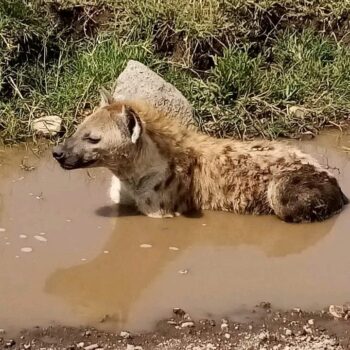
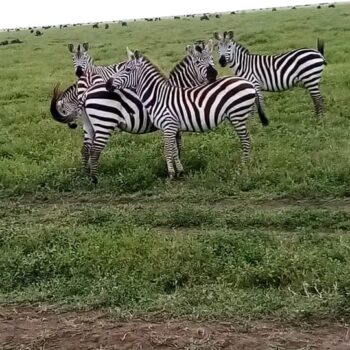
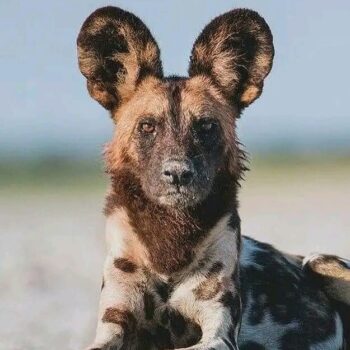
![IMG-20210627-WA0011[1016] IMG-20210627-WA0011[1016]](https://amanihostel.net/wp-content/uploads/2022/03/IMG-20210627-WA00111016-350x350.jpg)

